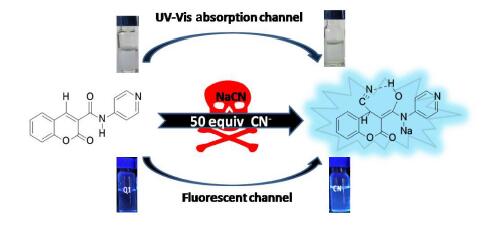摘要/Abstract

设计合成了一种基于N-4-吡啶基香豆素-3-甲酰胺的新型的CN-传感器Q1.通过紫外和荧光光谱研究了传感器Q1对10种不同阴离子的识别性能.当向含水10%(DMSO/H2O,V:V=9:1)的Q1中分别加入CN-,F-,Cl-,Br-,I-,AcO-,H2PO4-,HSO4-,ClO4-和SCN-等阴离子后,发现CN-的加入,使得Q1在304 nm处的吸收峰增强;相应的荧光光谱在431 nm处产生较强的发射峰;在365 nm紫外灯照射下,加入CN-的Q1溶液会产生蓝色荧光.同时,其它离子的加入无上述现象.Q1中加入CN-后光学性质改变的特点可实现在紫外、荧光双通道中检测CN-,并且对CN-的检测不受其它竞争离子的干扰.Q1对CN-的荧光最低检测限为1.44×10-8 mol/L,低于世界卫生组织(WHO)规定在饮用水中CN-的最高含量(<1.9μmol/L).另外,核磁滴定、红外、质谱结果表明,Q1对CN-可能的识别机理是这二者之间发生加成反应,此推断通过密度泛函计算亦可佐证.值得注意的是,该结果可应用于对樱桃核仁中CN-的检测,实现了在食物样品中的实时监测.
关键词: 香豆素衍生物, 荧光紫外双通道, 氰根离子, 食物样品应用
A novel CN- chemosensor based N-4-pyridylcoumarin-3-carboxamide derivative Q1 was designed and synthesized. The recognition performance of sensor Q1 for ten different anions was studied by UV and fluorescence spectroscopy. When anions such as CN-, F-, Cl-, Br-, I-, AcO-, H2PO4-,HSO4-,ClO4- and SCN- were added to the mixed solution (DMSO/H2O, V:V=9:1), addition of CN- could increase the absorption peak of Q1 at 304 nm, and the corresponding fluorescence produced a strong emission peak at 431 nm. Q1 solution with CN- emitted strong blue fluorescent that can be easily observed by naked eyes. The color changed (from colorless to faint yellow) and the "Turn-On" fluorescence behavior suggested that Q1 could detect CN- by dual-channel. Happily, the fluorescent limit of detection (LOD) is 1.44×10-8 mol/L, was lower than the specified content by World Health Organization (WHO) in drinking water. Based on all the experimental facts, we speculated that the possible identification mechanism was that the addition reaction took place between Q1 and CN-, and it can also be confirmed by density functional theory (DFT). This result can be applied to the detection of CN- in cherry kernel.
Key words: coumarin derivatives, dual-channel, cyanide ions, food sample application
PDF全文下载地址:
点我下载PDF
